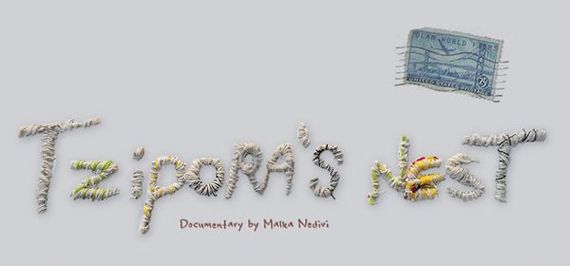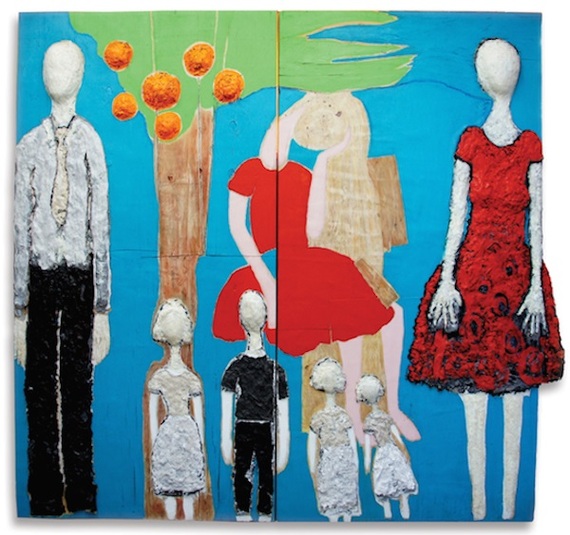
Malka Nedivi: Memory
"For a moment, I sensed that if any old object from my old world were to be discovered and scrutinized now, from my new viewpoint, it could be transformed into that magical piece children are always looking for." --Orhan Pamuk from The New Life
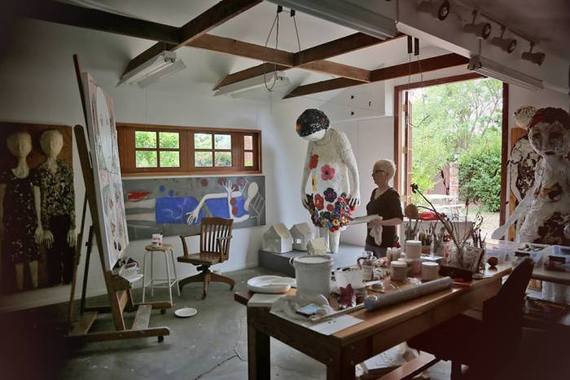
Malka Nedivi in her studio. Photo by Shoebox PR
Painter, sculptor, and accidental filmmaker Malka Nedivi's studio is an unruly treasure trove of found objects, non-traditional materials, personal narratives, family secrets, collective symbolism, dark wit, and an abiding affection for all things broken, lost, and redeemed. In her art practice, as in her moving new documentary on her mother's troubled legacy, we see that Nedivi's most singular gift is for transforming the literal and metaphorical artifacts of ruin into objects and experiences of folkloric, fantastical, and hypnotically eccentric beauty.
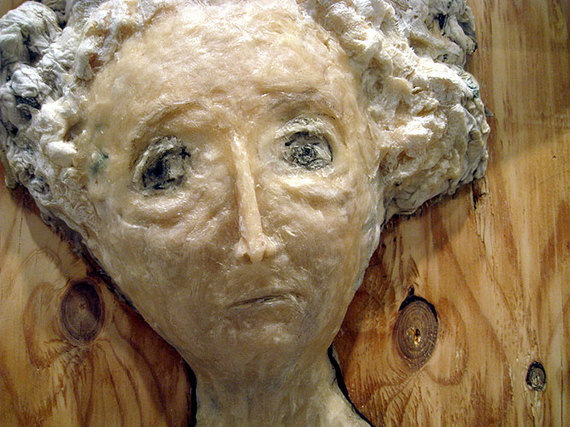
Malka Nedivi: Single Woman (detail)
As a painter and sculptor, Nedivi's subjects tend toward quasi-domestic settings and/or allegorical landscapes. She is attracted to imagery of homes, rooms, or surreally idyllic natural surroundings, presenting an inexhaustible array of stylized portraitures depicting single figures or small nuclear-family groupings, against either saturated, emotional color fields, or the fractal swirls in the grain patterns of wood panels, or both. Her figurative style is exuberantly unselfconscious and irreverently raw, with a folk-art flair for ambiguous symbolism and a narrative emotional depth. Her relationship to low-caste materials could drive the precious-minded to distraction, but her empathetic taste for the once-lost, re-used, re-purposed, and historiographically actual is a deliberate and indelible part of her practice -- and her personal story.
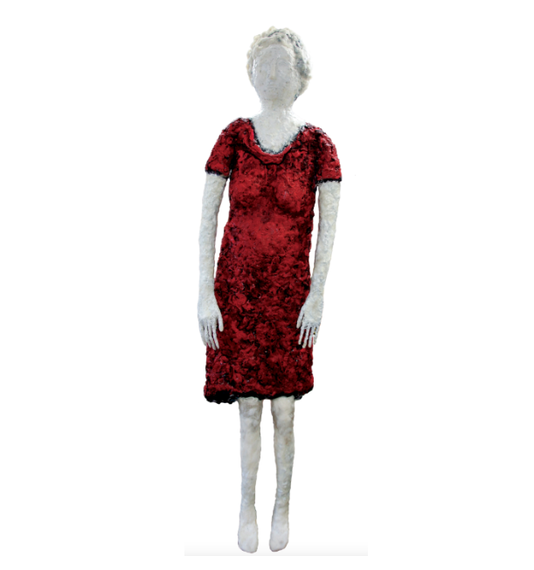
Malka Nedivi: Floating Woman
But a conversation about her "non-traditional" materials -- old clothes, found wood, rolls of delicate chicken wire and just bits of this and that -- contains an unexpected dimension. There's a moment toward the end of her documentary, when in confronting the aging, increasingly helpless, defiant hoarder her mother had become toward the end of her life, Tzipora tells Malka that the things she picks up in the streets are "precious treasures," objects she rescued because they spoke to her, and she was sure she'd find a use for them... someday. She, of course, never did. But Malka, well, she is actually using some of them and many other things like them, in her art, giving them the new life her mother foresaw, even as Malka struggles to heal the traumas that drove her to flee her childhood home.
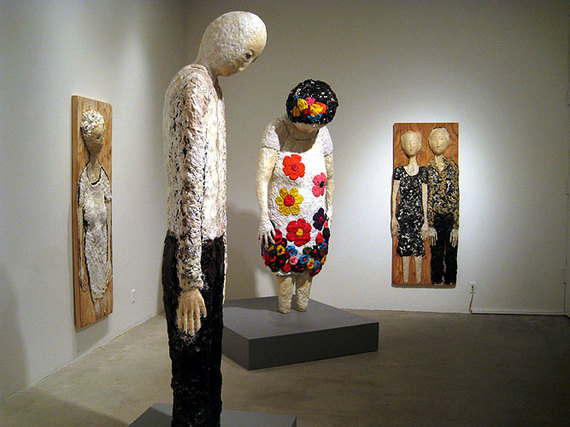
Malka Nedivi: Installation view with Man and Big Woman
Nedivi's large-headed, stooped, stolid bodies and faces are more about evocative mass and volume than likeness, as her imagery and materials fuse into facets of the same meaning; where what it is and what it's made of, why it looks how it does and what that means -- become singular to the artist's identity, against which she no longer struggles. Instead she seeks to redeem and transcend her own past -- to give all of it a new life, a fresh set of meanings, a legacy worthy of her mother's youthful, unimaginable heroism and the damage inflicted on her psyche during the Holocaust she survived. This is where the movie, even though it never mentions Malka's art practice, retroactively lays the foundation for the decades of work that came after it was filmed in 1996-2001, making it clear that what perhaps began as an experimental instinct has been elevated into a signature of deep significance. The work shows qualities of sculptors as diverse as Nikki de Saint-Phalle's feminine monumentality, Enrique Martinez Celaya's introspective melancholy, and the soulful, honorable despair of Joseph Beuys with his fat and felt -- all artists who, like Nedivi, treat a diasporic, paradoxical family legacy as fertile ground for cultivating a new history from the remains of the old.
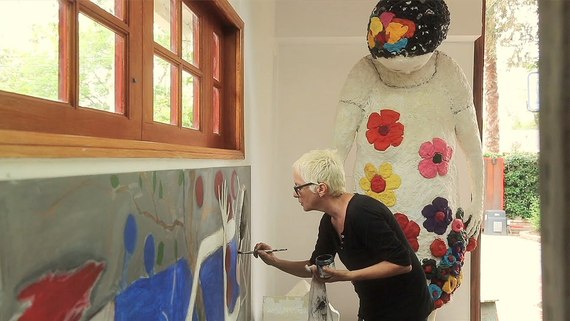
Malka Nedivi in her studio. Photo by EMS

Malka Nedivi: Woman
MALKA NEVIDI will screen her documentary feature TZIPORA'S NEST at the Skirball Center on Sunday, July 17, at noon, followed by a Q&A with the author. The event is free but space is limited, RSVP required.
Our 2024 Coverage Needs You
It's Another Trump-Biden Showdown — And We Need Your Help
The Future Of Democracy Is At Stake
The Wartime Updates You Need To Know
Your Loyalty Means The World To Us
As Americans head to the polls in 2024, the very future of our country is at stake. At HuffPost, we believe that a free press is critical to creating well-informed voters. That's why our journalism is free for everyone, even though other newsrooms retreat behind expensive paywalls.
Our journalists will continue to cover the twists and turns during this historic presidential election. With your help, we'll bring you hard-hitting investigations, well-researched analysis and timely takes you can't find elsewhere. Reporting in this current political climate is a responsibility we do not take lightly, and we thank you for your support.
Contribute as little as $2 to keep our news free for all.
Can't afford to donate? Support HuffPost by creating a free account and log in while you read.
The 2024 election is heating up, and women's rights, health care, voting rights, and the very future of democracy are all at stake. Donald Trump will face Joe Biden in the most consequential vote of our time. And HuffPost will be there, covering every twist and turn. America's future hangs in the balance. Would you consider contributing to support our journalism and keep it free for all during this critical season?
HuffPost believes news should be accessible to everyone, regardless of their ability to pay for it. We rely on readers like you to help fund our work. Any contribution you can make — even as little as $2 — goes directly toward supporting the impactful journalism that we will continue to produce this year. Thank you for being part of our story.
Can't afford to donate? Support HuffPost by creating a free account and log in while you read.
It's official: Donald Trump will face Joe Biden this fall in the presidential election. As we face the most consequential presidential election of our time, HuffPost is committed to bringing you up-to-date, accurate news about the 2024 race. While other outlets have retreated behind paywalls, you can trust our news will stay free.
But we can't do it without your help. Reader funding is one of the key ways we support our newsroom. Would you consider making a donation to help fund our news during this critical time? Your contributions are vital to supporting a free press.
Contribute as little as $2 to keep our journalism free and accessible to all.
Can't afford to donate? Support HuffPost by creating a free account and log in while you read.
HuffPost is dedicated to covering the devastating war between Hamas and Israel. We've broken news on the famine in Gaza, the State Department's turmoil, as well as what Hamas is thinking now — and we're far from done. HuffPost is committed to bringing you the critical updates you need to know. Would you consider contributing as little as $2 to support our reporting? Thank you for your support.
Can't afford to donate? Support HuffPost by creating a free account and log in while you read.
Dear HuffPost Reader
Thank you for your past contribution to HuffPost. We are sincerely grateful for readers like you who help us ensure that we can keep our journalism free for everyone.
The stakes are high this year, and our 2024 coverage could use continued support. Would you consider becoming a regular HuffPost contributor?
Dear HuffPost Reader
Thank you for your past contribution to HuffPost. We are sincerely grateful for readers like you who help us ensure that we can keep our journalism free for everyone.
The stakes are high this year, and our 2024 coverage could use continued support. If circumstances have changed since you last contributed, we hope you'll consider contributing to HuffPost once more.
Already contributed? Log in to hide these messages.








